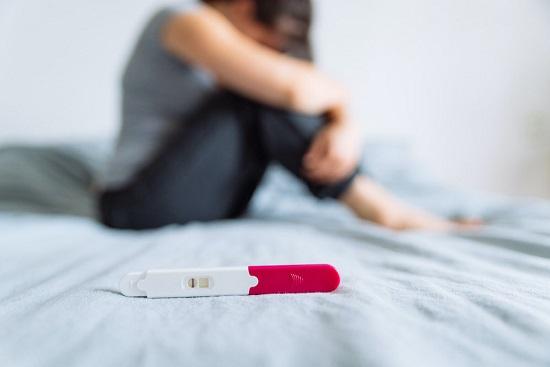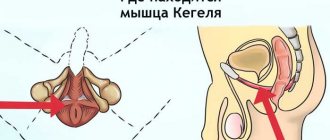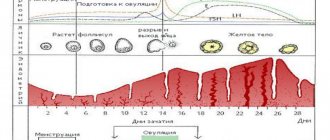markizwn
6-02-2017, 19:11
One of the main indicators of women's health is the monthly cycle. Its regularity indicates well-being in the field of a woman’s reproductive health, and the slightest deviation from the norm is a reason to consult a doctor. About the reasons for the violation of the monthly cycle.
Cycle disruption does not occur without cause and is always a consequence of something. There is a failure - you need to look for the reason.
The menstrual cycle
is a system of interconnection between the central nervous system and the endocrine glands: the hypothalamus, pituitary gland, ovaries, adrenal glands, thyroid gland, and uterus.
Consequently, failures in the operation of one of the links in the chain lead to a change in the cycle. There are many reasons that provoke disruption of the monthly cycle. First of all, this may be due to the presence of gynecological diseases: ovarian cysts, polyps, fibroids, endometrial hypoplasia, inflammatory diseases, etc. Almost any change in the health of the female reproductive system will immediately affect the cycle. Affects the monthly cycle and mental health. Failures can occur due to changes in climatic zones, diets, and while taking certain medications: antibiotics, antidepressants, tranquilizers. Statistics in numbers.
- The average monthly cycle for most women lasts from 21 to 36 days.
- The duration of the menstrual period is from 3 to 7 days.
- The volume of blood loss during menstruation is from 50 to 150 ml.
- For the first two years, periods may be irregular, which is normal.
- You should know that the menstrual cycle is counted from the first day of menstruation.
Complete absence of menstruation. The complete absence of menstruation, or amenorrhea, is also one of the options for disrupting the menstrual cycle. Amenorrhea can be primary (there was not even the first menstruation), secondary (there were menstruation, but disappeared for some reason), true and false. With true amenorrhea, the absence of menstruation is associated with a cyclic transformation of the endometrium: in other words, the endometrium does not mature in the uterine cavity. With false amenorrhea, the endometrium matures, but the outpouring of menstrual blood does not occur due to any obstacle - for example, with anatomical defects. Amenorrhea can also be physiological, age-related - before the onset of the first menstruation and after the onset of menopause, as well as during pregnancy and lactation. Does missing periods affect your health?
In a situation where a disruption in the monthly cycle is caused by a certain disease, everything is clear: we treat the disease and the cycle is restored.
But what if menstruation disappeared, say, due to long-term use of medications? It cannot be said that this will entail any serious health problems. However, there is a connection between sex hormones and thyroid hormones, the function of the latter may be impaired. Endocrine imbalance - be it a lack or excess of hormones - will immediately affect a woman’s well-being. A lack of thyroid hormones is usually manifested by apathy, lethargy, bad mood, bradycardia, and dry skin. With an excess of hormones, tachycardia of unknown etiology, sweating, acne, and deterioration of hair condition may be observed. The monthly cycle and hormonal contraceptives.
Thanks to oral hormonal contraceptives, we can independently regulate our menstrual cycle.
How often can you “skip” your period and how harmless is it? You can artificially stop menstruation by taking pills continuously only in emergency cases and for a maximum of one or two cycles. As a rule, women resort to this measure while traveling on vacation. If we disrupt the cycle more often, then, by suppressing the function of the ovaries, we will achieve their depletion, and subsequently it will be difficult to restore ovulatory function. You can’t just interfere with nature without consequences. When should you see a doctor?
What symptoms indicate that not everything is fine in the body? All those that fall out of the usual norm. Namely:
- bleeding in the middle of the cycle;
- if the duration of the monthly cycle has increased or decreased;
- large blood loss;
- blood loss in the form of clots;
- unpleasant odor;
- if your periods become very painful, etc.
Remember that a healthy lifestyle, regular examinations, timely consultation with a doctor and proper treatment of diseases will help reduce the risk of many problems! Women's health Health of the child and the whole family
When an irregular cycle is not a pathology
Normally, menstruation should be regular, arriving after a certain number of days (with a deviation of no more than 3 days). The duration of the cycle should be no less than 21 and no more than 35 days. There may be exceptions in which the cycles are slightly shorter or longer (this is due to the genetic characteristics of the body). Violation of the regularity of the cycle can be spontaneous, one-time (for example, due to climate change, experienced stress, sudden weight loss), but it can also be long-term, even permanent.
At certain periods of life, irregular periods occur due to natural physiological processes occurring in the body and are not considered a pathology. So, at the beginning of puberty, for 1-2 years, a girl’s menstruation comes chaotically, since during this period the development of the genital organs occurs, and the level of hormones that regulate the processes of the cycle has not yet been established.
After childbirth, a woman’s periods usually appear after breastfeeding ends, and at first, while hormonal levels are restored, they may be irregular.
The cycle is disrupted when using hormonal contraceptives. Irregular spotting most often occurs within 3-4 months of starting to take birth control pills or after abruptly stopping their use.
Note: Some women deliberately violate the schedule for taking oral contraceptives in order to delay or accelerate the onset of menstruation. In this case, there is a risk of persistent irregularities in the menstrual cycle or the onset of amenorrhea.
During premenopause, interruptions in the onset of menstruation are also natural. Due to the aging of the ovaries and the depletion of the supply of eggs in the body, another hormonal change occurs. At the same time, periods are irregular, and after some time they disappear completely.
The occurrence of interruptions is facilitated by the use of certain medications (hormonal drugs, tranquilizers, anticoagulants), and alcohol abuse.
Video: How menstrual irregularities manifest themselves
Recommendations for normalizing your cycle

It has been scientifically proven that menstrual irregularities can be not only functional, but also associated with serious gynecological pathology. A specialist doctor must determine the true cause of the problem with the reproductive system and prescribe appropriate treatment. However, we can list general recommendations that will help with functional disorders. How can you normalize the menstrual cycle without hormonal medications:
Only a doctor can give the most correct recommendations after conducting a comprehensive examination of the patient.
The menstrual cycle is closely related to all processes in the female body, so any deviation cannot be ignored. There are various pills to normalize the menstrual cycle, as well as gels and settings. But the effectiveness of treatment depends not only on the correct choice of drug, but also on compliance with the instructions.
Pathologies leading to cycle disruption
The cause of the pathological failure may be diseases of the endocrine glands and genital organs, injuries to the uterus and ovaries, surgical operations on them, as well as poisoning of the body with toxins, blood diseases, and physical overload.
Irregular cycle as a sign of disease
Diseases, the symptom of which are menstrual disorders, are often associated with hormonal disorders in the body.
Hyperprolactinemia. An increased level of the hormone prolactin in the blood leads to a decrease in the level of estrogen and progesterone, as a result of which menstruation comes with a great delay, becomes scanty or disappears completely. With this pathology, accompanying symptoms in women are the release of milk from the nipples during periods not associated with breastfeeding, growth of facial hair, and infertility. The pathology can be caused by pituitary tumors, thyroid dysfunction, taking antidepressants and some other medications.
Polycystic ovary syndrome. If there are cystic formations in the ovaries, a woman may experience delayed periods and intermenstrual bleeding. Symptoms also include weight gain and hair growth in areas of the body that are not typical for women.
Benign and malignant tumors of the uterus and ovaries (cystoma, fibroids, cancer). Such diseases are characterized by the appearance of pain in the lower abdomen, chaotic bleeding, and pathological discharge between menstruation.
Inflammatory and infectious diseases of the genital organs affect the condition of the endometrium and can accelerate or slow down its rejection, with irregular periods being a symptom. A pathology such as inflammation of the ovaries can itself cause hormonal disorders in the body.
Endometrial hyperplasia, endometriosis, adenomyosis. Hormonal imbalance leads to improper development of the endometrium, as a result of which menstruation becomes painful and occurs irregularly. Dangerous intermenstrual bleeding occurs.

Causes of cycle disruptions in teenagers
If after 2 years a girl’s cycle has not established itself, her periods come irregularly, this indicates some kind of health problem. The chaotic onset of menstruation is typical for exhausted teenagers who are addicted to starvation diets, which sometimes leads to anorexia. Vitamin deficiency and anemia can also cause deviations. Increased nervousness, emotionality, and a tendency to hysteria often lead to irregular periods.
Causes of irregular periods may also include:
Often this causes so-called juvenile uterine bleeding. Their appearance can be triggered by physical fatigue, mental trauma, poor nutrition, and illness.
What are the dangers of cycle disorders?
Pathologies of menstrual function cause severe complications, including:
- Anemia. Frequent heavy bleeding leads to the fact that the bone marrow does not have time to restore the number of red blood cells. Women feel weakness, decreased performance, are constantly worried about shortness of breath and dizziness, and fainting occurs in stuffy rooms.
- Infertility. Irregular ovulation and impaired preparation of the uterus for implantation make it impossible to conceive a child. The diagnosis is made if a girl cannot become pregnant after 12 months of sexual activity without using contraception.
- Malignant tumors. Hormonal disruptions lead to impaired tissue differentiation, which increases the risk of breast, cervical, and ovarian cancer.
- Hematometra. The accumulation of blood during menstruation creates a favorable environment for the development of pathogenic microbes, resulting in purulent endometritis with the risk of generalization of infection.

Diagnosis and treatment
Before prescribing treatment, an examination is carried out to determine the reasons why menstruation has become irregular.
When diagnosing, methods such as blood tests for hemoglobin, the content of individual microelements, sugar, as well as hormones and the presence of infectious agents are used. The presence of diseases can be determined using ultrasound and MRI.
If it is determined that there are no serious pathologies, then to restore the cycle, vitamins A, E, C and group B, sedative drugs are prescribed, and general strengthening procedures are recommended. If diseases caused by hormonal imbalance are detected, hormone replacement therapy is carried out. For women of reproductive age, taking oral contraceptives according to a specific regimen helps restore their cycle. If there is an excess of estrogen in the body, drugs based on progesterone (Utrozhestan, Duphaston) are prescribed, and if there is a deficiency, testosterone (Norkolut) or estradiol (Levonorgestrel).
Treatment of concomitant diseases of the liver, thyroid gland and other organs involved in the formation of hormones and hematopoiesis is carried out. Iron supplements are also prescribed to eliminate anemia, and antiviral and antibacterial treatment is carried out.
In the presence of uterine bleeding, the uterus is curetted and the endometrium, which has various defects, is removed. Subsequent hormonal treatment helps prevent the recurrence of disorders and the development of pathologies such as irregular periods.
To improve the functioning of the ovaries, medications are prescribed that stimulate the maturation of follicles and increase the production of estrogen and progesterone. Such drugs (“Choriogin”, “Pergonal”) are used in the treatment of infertility.
Video: Treatment of menstrual irregularities
Admit it, have you ever had to deal with the problem of menstrual irregularities? Please note that irregular periods can be a sign of hormonal imbalance and other serious health problems. In this article, we have collected the 6 most common causes of irregular menstruation.
Menstrual irregularities and delayed periods can be caused by various factors. That is why, if you have such a problem, we advise you to immediately consult a gynecologist to establish the correct diagnosis.
The menstrual cycle is a biological and hormonal process that women of a certain age regularly go through. The course of menstruation directly depends on the psychological and physiological health of a woman.
The average duration of the menstrual cycle is 28 days. Menstruation itself lasts from 3 to 6 days, but everything depends on the hormonal state of each woman.
During each subsequent menstruation, a number of changes occur in a woman’s body that affect her sexual and reproductive functions. However, unfortunately, some women ignore the first alarm bells, which may be indicated by irregular menstruation and a change in the nature of discharge.
The length and pattern of periods can change throughout life, and this is due to different hormone levels between puberty and menopause.
Every woman needs to be able to distinguish the signs of menstrual irregularities, because they may indicate hormonal changes in the body and serious disorders in the functioning of internal organs.
If your periods are often delayed or, on the contrary, begin earlier than the usual schedule, we advise you to consult a gynecologist to identify the cause of irregular menstruation.
Irregular menstruation - causes
Of course, you shouldn’t set yourself up for negativity ahead of time, but after the first signs of menstrual irregularities appear, it is better to consult a specialist to avoid further complications.
Most women who suffer from irregular periods do not understand the reasons for their menstrual irregularities. That's why we took the opportunity to bring you the top 6 causes of irregular periods.
Thyroid problems
Disorders in the thyroid gland are the main triggers of menstrual irregularities.
Since this organ is responsible for the production of vital hormones, their imbalance leads to amenorrhea (absence of menstruation for 6 months or more) and irregular menstruation. Statistics indicate that about 15% of women with amenorrhea also have problems with the thyroid gland.
Some experts consider the thyroid gland to be the main gland in the body, because among its main functions is control over the endocrine system, metabolic rate and sexual libido of a person.
Stopping birth control
Oral contraceptives are intended for birth control and prevention of unwanted pregnancy.
These pills maintain high levels of estrogen in the body. The body perceives this state of affairs as pregnancy, and therefore prevents fertilization.
After 21 days of regular use of contraceptives, you must take a seven-day break, after which the cycle is repeated again.
The problem is that often after stopping taking contraceptives, certain changes can occur in a woman’s body, in particular menstrual irregularities and absence of menstruation.
Studies have shown that about 29% of women who stop taking contraceptives do not have a period within three months.
Intense physical activity
Intense physical activity can cause changes in the functioning of the adrenal glands, thyroid glands and brain appendage. So, you should be careful with sports, because grueling workouts can not only disrupt the menstrual cycle, but also adversely affect the functioning of other internal organs.
What is considered a violation of regularity?
Normally, the duration of the menstrual cycle is from 21 to 35 days. Menstruation that does not fit into this period is considered irregular. Moreover, if in one month the duration was 25 days, and in the next - 34, in principle, this cannot be called a strong violation, although in such situations it is better to approach each case individually. Most common changes:
- amenorrhea – absence of menstruation for more than six months;
- proyomenorrhea – shortening of the cycle, less than 21 days;
- oligomenorrhea - with the regularity of menstruation every three to four months.
Minor disruptions are usually referred to simply as delays.
We recommend reading the article about getting your period ahead of schedule. From it you will learn about the causes of premature menstruation, physiological and pathological problems, the need to see a doctor and get tested, as well as normalize the cycle.
What is an irregular menstrual cycle?
The concept of “ irregular periods ” is often associated with a temporary failure in the system. Irregularity of menstrual flow is always combined with a change in its basic characteristics: it is abundant or scanty, sharply painful. Therefore, it is more correct to decipher this term as “menstrual cycle disorder.” However, it is the irregularity of the appearance of monthly bleeding that is the most common reason for a woman to visit a doctor among all possible menstrual cycle disorders.
The normal cycle length is 21-31 days with a possible deviation up or down of 5-7 days. If your period comes after 40-50 days or starts too early - after 2 weeks - you can call the menstrual cycle irregular .
What affects the menstrual cycle?
If you have a regular menstrual cycle, starting at the same time every month, consider yourself truly lucky. But still, most women cannot boast of such luck. Why? Here's how and what can affect the menstrual cycle?
The menstrual cycle is considered normal if it has an average duration of 28 days; it should not be less than 21 or more than 35 days. The average duration of menstrual bleeding lasts about 5 days; normal values can also be considered to be no less than 3 and no more than 8 days. In terms of quantity, during one menstruation a woman loses from 50 to 100 ml of blood with impurities. Anything less or more than these numbers is an alarming signal, a deviation from the norm. And the most common problem with which women turn to a gynecologist is menstrual irregularities.
What are the most common menstrual irregularities?
Most often, women consult a doctor with problems associated with menstrual irregularities such as delayed menstruation, severe pain and excessive bleeding. Sometimes, when changing the way and rhythm of life, these problems are solved by themselves.
However, sometimes more serious disruptions in the cycle occur, which require immediate consultation with a gynecologist and possible treatment. Let's list them.
Amenorrhea is the absence of menstruation. Dysmenorrhea is painful menstruation. Menorrhagia (hypermenorrhea) is excessively heavy menstrual bleeding. Oligomenorrhea - cycles with long breaks, more than 35 days. Polymenorrhea is a new menstrual cycle that occurs frequently, more often than every 21 days.
There is also such a disorder as light bleeding; it occurs at any time during the normal cycle.
There are women who know exactly on what day, and maybe even the hour, their menstruation will begin. But the majority still do not have such an accurate cycle, and each time they are unpleasantly surprised, because menstruation begins at the most inopportune moment, stains on white trousers or a swimsuit are very upsetting.
For some women, menstruation occurs quickly, only 3-4 days without heavy bleeding and pain, while for others the opposite happens. That's why many people strive to be able to control their cycle. But to achieve this, you need to know what affects the menstrual cycle. Then it will be possible to understand how to prevent irregularities in the menstrual cycle.
Most often, hormonal imbalance, stress, strict diets, fatigue, and lack of sleep lead to distortion of the cycle. Traveling on long flights, changing time zones, and climate change also affect the frequency, duration and heaviness of menstruation.
What else?
Sudden changes in body weight, breastfeeding, ectopic pregnancy, a number of medications and illnesses (thyroid disorders, polycystic ovary syndrome, cervical cancer, infections, sexually transmitted diseases, diabetes, anorexia, depression), caffeine and smoking can also have a negative effect on the regularity, duration and abundance of menstruation.
To bring the menstrual cycle back to normal, you must constantly lead a healthy lifestyle, follow a sleep and nutrition schedule. Moving more, avoiding a sedentary and passive lifestyle, taking time for daily walks in the fresh air, doing physical exercise, eating healthy foods, eating more fruits and vegetables, including foods rich in protein and omega-3 fatty acids in your diet will also be useful in reasonable quantities of cocoa and chocolate.
Irregular menstruation: normal or pathological?
Irregularity of menstruation does not always indicate the development of pathology. In some cases, such a phenomenon can be caused by natural physiological processes in the body, which can occur at different periods of a woman’s life.
During reproductive age
The following physiological factors can lead to disruptions in the menstrual cycle of women of reproductive age:
- recent abortion;
- curettage procedure after spontaneous miscarriage;
- recovery period after childbirth (this also includes irregular periods during breastfeeding )
In these cases, the woman’s cycle normalizes on its own.
In teenagers
A couple of three teenage girls aged 11-17 years have irregular periods. This does not apply to pathological phenomena. The irregularity of the appearance of menstrual flow indicates the fact of an insufficient amount of hormones produced, which are unable to systematize and synchronize menstruation. As the girl grows, the cycle is restored.
During menopause
An irregular menstrual cycle at age 40 may indicate perimenopause, the period preceding menopause. This is explained by changes occurring in a woman’s body caused by a decrease in ovarian function. Disruptions in the cycle can be observed throughout the year (sometimes longer), then menstruation disappears. This condition is also considered normal.
Causes of menstrual cycle disruption
Etiological factors are divided into physiological and pathological. The first include natural age-related changes: the absence or irregularity of a cycle in teenage girls under 16 years of age does not cause concern. If critical days do not occur after adolescence, amenorrhea is diagnosed. In women over 45 years of age, irregularities in the menstrual cycle are a normal phenomenon, which indicates the body’s preparation for the completion of reproductive function and the transition to menopause.
Physiological factors include:
- frequent stress;
- physical or mental fatigue;
- unbalanced diet;
- climate change, regular trips to other countries;
- pregnancy and the period after childbirth (up to 1 year);
- sexual contacts (failures occur after the first time)
The pathological causes of menstruation failure are varied. They include inflammatory, tumor, hormonal diseases of the reproductive system, chronic somatic pathologies, diseases of the parts of the central nervous system responsible for the regulation of female cycles.
Medicinal predisposing factors are included in a separate classification. Irregular periods are observed with the use of hormonal drugs, psychotropic drugs, anticoagulants, and anticonvulsants.
Pathological causes of failures
Irregular menstrual blood may indicate the progression of various pathologies of a woman’s reproductive system. Among the most common of them:
- PCOS (polycystic ovary syndrome);
- neoplasms;
- myoma;
- polyps;
- endometritis in chronic form;
- endometriosis.
An incorrectly selected contraceptive or prolonged use of the product can also lead to an unpleasant phenomenon.
Other diseases that negatively affect a woman’s hormonal levels can also lead to disruptions in the menstrual cycle. Among the most likely pathologies:
- diseases of the endocrine system, including the thyroid gland;
- violations of the functional ability of the hypothalamus, pituitary gland;
- rapid loss of body weight;
- anomalies in the structure of the organs of the reproductive system (double uterus, septum in the reproductive organ, infantilism, etc.).
Often, psychological disorders, alcohol and smoking abuse, vitamin deficiency, and chromosomal diseases are the provocateurs of disruptions in the cycle.
Classification of menstrual disorders
The modern classification of disorders of the frequency, periodicity of menstruation, intensity and time of appearance of blood is defined in the following terms:
- hypermenorrhea. Heavy (more than 80 ml) uterine bleeding, lasting more than a week and occurring regularly (interval);
- metrorrhagia. Uterine bleeding, appearing irregularly, at short intervals, often prolonged, of varying intensity;
- menometrorrhagia. Prolonged bleeding from the uterus, appearing irregularly;
- intermenstrual discharge. Observed in the periods between regular menstruation, varying in intensity;
- polymenorrhea. Uterine bleeding that appears regularly at short intervals (less than 21 days);
- oligomenorrhea . Rare menstruation with breaks of more than 40 days;
- amenorrhea. Absence of bleeding for six months or more;
- dysfunctional uterine discharge. Acyclic bleeding, observed regardless of organic disorders.
Alarming symptoms – a reason to visit a gynecologist
There are a number of manifestations that will serve as a “wake-up call” for a woman faced with the problem of irregular menstruation. You can recognize something is wrong by the following symptoms:
- a fat metabolism disorder, expressed in acne, excess weight;
- hirsutism - abundant hair growth in the area of the face, chest, abdomen, and limbs. A similar phenomenon occurs in 25% of women who have irregular periods;
- signs of a male physique (active development of the muscular skeleton);
- decreased level of sexual desire.
In addition, many women are interested in whether it is possible to get pregnant with an irregular menstrual cycle . If the discharge is unsystematic, patients often face the inability to conceive. According to statistics, no more than 20% of women manage to get pregnant on their own.
How to restore the cycle?
Since cycle irregularity is not a disease, but only a single symptom, treatment for the process may vary depending on the cause of the failure. We are talking about the following treatment approaches:
- Identification and treatment of the underlying disease.
- Prescription of contraceptives.
- Changing the method of contraception.
- Lifestyle changes.
- Symptomatic treatment.
Drug therapy for the underlying disease
The most common causes of irregular periods are thyroid disease and polycystic ovary syndrome. In the first case, medications are prescribed to normalize its functioning (Iodomarin, Eutirox). When hormone concentrations are reduced, hormone replacement therapy is prescribed. With active hormone production, treatment is carried out by suppressing the activity of the gland. In some cases, surgery is recommended.
When it comes to polycystic ovary syndrome, hormonal contraceptives (Jess, Midiana, Yarina) come to the patient’s aid. If there is a prolonged delay due to the development of pathology, Duphaston may be prescribed.
Contraceptive therapy
Combined oral contraceptives or COCs can be used to treat irregular menstruation even in the absence of sexual activity. Among the most common representatives: Marvelon, Silest, Ovidon, Rigevidon, Non-Ovlon.
Sometimes COCs are prescribed to women planning pregnancy in the absence of regular periods. Taking these medications for six months or more leads to normalization of the cycle.
Changing your contraceptive method
If irregular uterine bleeding is caused by taking birth control pills, specialists will prescribe the woman a suitable alternative: a drug with a different hormonal composition or a higher concentration.
When the problem is caused by an intrauterine device, the only way out of this situation is to prescribe a different type of contraception.
Lifestyle change
If a malfunction in the body is caused by excessive physical exertion, stress, or malnutrition, it is worth taking a break and observing how the situation changes as conditions change.
Symptomatic therapy
To “extinguish” the following types of drugs that appear against the background of irregular menstrual symptoms:
- analgesics (to relieve pain);
- hemostatic agents (Ditsinon, Vikasol);
- non-steroidal anti-inflammatory drugs;
- antibacterial drugs (for inflammation);
- vitamin complexes (if the body is weakened).
In case of severe uterine bleeding that does not subside with conservative treatment, curettage of the uterine cavity is performed.
Folk remedies
To restore regular periods, traditional medicine methods are used as maintenance therapy. Among the most proven means are:
- ginger. Relieves pain, restores the cycle. Ginger tea is used for medicinal purposes: ½ tsp. Pour the ground root into a glass of water and boil. Strain, add a little sugar and drink three times a day;
- sesame seeds. We are talking about the plant equivalent of the female sex hormone. 2 tbsp. l. Grind the raw materials in a coffee grinder, pour in 1 tsp. palm oil, mix the ingredients and eat 1 tsp. once a day;
- cinnamon. Relieves spasmodic pain in the uterus during menstruation. You need to add 1 tsp. ground seasonings in 200 ml of milk or kefir. Drink the drink for 14 days;
- aloe and honey. Mix 1 tsp. honey and the same amount of aloe juice and eat ½ tsp. remedies on an empty stomach for 30 days.
For medicinal purposes, you can also use turmeric, coriander, fennel, mint, mixing the components with honey.
Preventive measures
Prevention of irregular menstrual cycle is aimed at preventing provoking external and internal factors. You can prevent the occurrence of hormonal imbalances using the body’s natural forces by following a number of simple recommendations:
- minimize stressful situations. If, due to a number of life circumstances, a woman is constantly under stress, she is advised to take a course of sedatives: Sedavit, Adaptol, etc.;
- organize nutritious meals;
- take multivitamin complexes to avoid weakening the immune system and the development of vitamin deficiency;
- give up bad habits (drinking alcohol, smoking);
- follow measures to prevent pathologies of the reproductive system and STDs;
- Check regularly with a gynecologist (at least once a year).
Consequently, irregular periods can be caused by both external and internal factors and be of both physiological and pathological nature. The nature of the phenomenon can be determined by a doctor who will not only establish the fact of pathology, but also determine the type of menstrual disorder. Based on the diagnosis, appropriate therapy is carried out aimed at restoring the regularity of menstruation. Therapeutic measures can be aimed at eliminating the primary disease or involve changing lifestyle, contraceptive methods, relieving concomitant symptoms, and hormonal therapy. Folk remedies in the case of irregular menstruation are justified only as an auxiliary therapy, subject to prior medical consultation. Prevention of pathology is aimed at preventing the occurrence of provoking factors.
Recovery methods
The ability to return menstruation with the help of special medications or traditional medicine must be entirely determined by the cause of the disorder itself. In many cases, the recommendations of the attending physician are limited to the need to establish a nutritious diet and reduce the degree of regular physical activity.
Taking various medications is usually associated with the diagnosis of more serious disorders. Often, in order to resume a normal menstrual cycle due to existing diseases of the reproductive system, surgical intervention is necessary.
General recommendations
From the list of useful general recommendations, we should highlight bringing your diet and physical activity back to normal, eliminating sources of constant stress, as well as getting rid of unnecessary worries. To normalize the cycle, it is also recommended to establish an active sex life, since it is during the process of quality sex that the female body produces endorphin, enkephalin, oxytocin and other types of sex hormones. With their help, the functioning of the nervous system is restored.
You should also not refuse the opportunity to take vitamins regularly. This is especially true for folic acid, vitamins A and E, as well as a substance such as ascorutin.
Medicines
Normalizing the cycle by taking medications is allowed only under the supervision of the attending physician. This applies not only to the list of possible drugs, but also to their daily dosage and the total duration of the entire treatment course. If the prescribed treatment does not give the desired effect, namely the ability to restore menstruation, the therapy must be adjusted.
The entire range of medications that a gynecologist can prescribe should be divided into three main groups:
- drugs with synthetic hormones;
- herbal remedies made from natural ingredients, the composition of which is almost identical to the hormones produced by the body;
- dietary supplement (biologically active additives).
By taking such drugs in the female body, hormonal balance is restored artificially. The only caveat is the duration of their use.
Drugs with artificial hormones include Cycloproginova, Divitren and Cliogest. If in the first case it is possible to treat the disorder by replenishing the required amount of estrogen (which promotes the correct process of regeneration of the functional layer of the endometrium), then the second drug is necessary as a preventive measure for the manifestation of malignancy and hyperplasia. The traditional use of the drug Cliogest is aimed at restoring the usual menstrual cycle. It should also be taken to prevent possible uterine bleeding and alleviate the pain associated with the onset of menopause.
From the list of phytohormones, a doctor may prescribe Besser Alter, which was created based on a collection of Altai herbs, due to which the product activates the work of the ovaries and thereby causes the onset of menstruation. The drug itself is often used to restore the reproductive function of the female body, as well as to mitigate the signs of the onset of menopause. It can be taken to slow down the aging process, reduce sweating, hot flashes and irritability associated with the onset of menopause. You can normalize the menstrual cycle with the help of a drug such as Feminal, which is also effective in eliminating acyclic bleeding and the most pronounced signs of PMS.
The drug Estrovel is a biologically active supplement that serves as an auxiliary remedy for hormonal imbalance, painful signs of premenstrual syndrome and the need to correct the onset of menstruation.
If the reason for the delay in menstruation lies in concomitant disorders, for example, inflammatory processes in the pelvic organs or infection with ARVI, then the disease itself must be treated. The menstrual cycle usually returns on its own.
In any case, it is extremely important to observe the dosage of the drug, the total duration of the treatment course, and also carefully monitor the condition of the body itself. At the first violation, you should contact your doctor.
Folk remedies
To restore the menstrual cycle without hormones and appropriate medications, you should use folk remedies to normalize menstruation. The list of effective folk methods of treatment includes:
- oregano, the plants of which can be added directly to tea in small quantities or a separate infusion can be prepared from it;
- parsley, the leaves of which are best eaten fresh during regular meals;
- linden flowers, which need to be collected in July and then prepared as an infusion;
- sage, which is also brewed as tea;
- horseradish root juice (drink 1 teaspoon 2-3 times a day with water);
- herbal teas from lemon balm;
- decoction of onion peels.
To prepare an effective home remedy, you can use 25 g of red brush and hogweed plants, which are infused in alcohol for 14 days. The finished infusion should be taken three times a day, one teaspoon at a time. Instead, you can also prepare an infusion of wormwood. To do this, use a third of a tablespoon of dry raw materials per 200 ml of boiling water. You need to insist for about 4 hours. Take a quarter glass 4 times a day. It is not allowed to increase the daily dosage.
An infusion using dandelion root will help make your periods less painful. To do this, you need a teaspoon of crushed roots and a glass of water. The mixture must be boiled and simmered over low heat for 5 - 7 minutes. After two hours of infusion, the decoction is ready for use, half a glass twice a day before meals.











